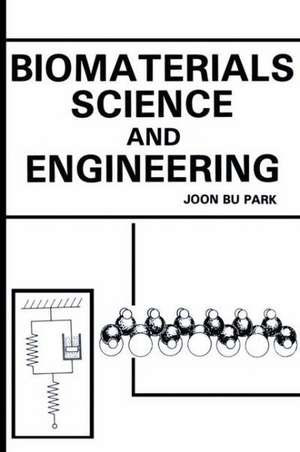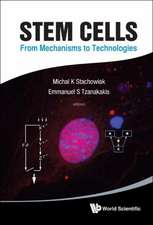Biomaterials Science and Engineering
Autor Joon B. Parken Limba Engleză Paperback – 27 aug 2013
Preț: 837.78 lei
Preț vechi: 1021.69 lei
-18% Nou
Puncte Express: 1257
Preț estimativ în valută:
160.32€ • 168.58$ • 132.46£
160.32€ • 168.58$ • 132.46£
Carte tipărită la comandă
Livrare economică 17 aprilie-01 mai
Preluare comenzi: 021 569.72.76
Specificații
ISBN-13: 9781461297109
ISBN-10: 1461297109
Pagini: 480
Ilustrații: XV, 459 p. 183 illus.
Dimensiuni: 152 x 229 x 25 mm
Greutate: 0.64 kg
Ediția:1984
Editura: Springer Us
Colecția Springer
Locul publicării:New York, NY, United States
ISBN-10: 1461297109
Pagini: 480
Ilustrații: XV, 459 p. 183 illus.
Dimensiuni: 152 x 229 x 25 mm
Greutate: 0.64 kg
Ediția:1984
Editura: Springer Us
Colecția Springer
Locul publicării:New York, NY, United States
Public țintă
ResearchDescriere
This book is written for those who would like to advance their knowledge beyond an introductory level of biomaterials or materials science and engineering. This requires one to understand more fully the science of materials, which is, of course, the foundation of biomaterials. The subject matter of this book may be divided into three parts: (1) fundamental structure-property relationships of man-made materials (Chapters 2-5) and natural biological materials, including biocompatibility (Chapters 6 and 7); (2) metallic, ceramic, and polymeric implant materials (Chapters 8-10); and (3) actual prostheses (Chapters 11 and 12). This manuscript was initially organized at Clemson University as classnotes for an introductory graduate course on biomaterials. Since then it has been revised and corrected many times based on experience with graduate students at Clemson and at Tulane University, where I taught for two years, 1981-1983, before joining the University of Iowa. I would like to thank the many people who helped me to finish this book; my son Y oon Ho, who typed all of the manuscript into the Apple Pie word processor; my former graduate students, M. Ackley Loony, W. Barb, D. N. Bingham, D. R. Clarke, J. P. Davies, M. F. DeMane, B. J. Kelly, K. W. Markgraf, N. N. Salman, W. J. Whatley, and S. o. Young; and my colleagues, Drs. W. Cooke, D. D. Moyle (Clemson G. H. Kenner (University of Utah), F. University), W. C. Van Buskirk (Tulane University), and Y.
Cuprins
1 Introduction.- 1.1. Definition of Biomaterials.- 1.2. Brief Historical Background.- Problems.- References.- 2 Characterization of Materials.- 2.1. Mechanical Properties.- 2.1.1. Atomic Bonding and Elasticity (Hooke’s Law).- 2.1.2. Mechanical Property Measurements.- 2.2. Viscoelasticity.- 2.3. Viscoelasticity in Dynamics Tests.- 2.4. Elasticity of Non-Hookean Materials.- Problems.- References.- 3 Structure of Solids.- 3.1. Atomic and Molecular Bonding.- 3.1.1. Primary Bonding.- 3.1.2. Secondary Bonding.- 3.2. Crystal Structure of Solids.- 3.3. Crystal Imperfections.- 3.3.1. Point Defects.- 3.3.2. Line Defects (Dislocations).- 3.3.3. Grain Boundaries.- 3.4. Noncrystalline Solids.- 3.4.1. Long-Chain Molecular Compounds.- 3.4.2. Network Structures.- Problems.- References.- 4 Thermodynamics of Structural Changes.- 4.1. Thermodynamic Relationships.- 4.1.1. Energy, Enthalpy, and the First Law of Thermodynamics.- 4.1.2. Entropy and the Second Law of Thermodynamics.- 4.1.3. Free Energies: The Thermodynamic Potentials.- 4.2. Rates of Reactions.- 4.3. Phase Changes.- 4.3.1. Single-Component Systems: Allotropy.- 4.3.2. Composition and Phase Stability.- 4.3.3. Mechanism of Phase Changes.- 4.3.4. Time-Temperature Transformation of Steel.- 4.4. Diffusion.- 4.5. Surface Properties.- 4.5.1. Surface Tension.- 4.5.2. Surface Tension Measurements of Solids.- Problems.- References.- 5 Strength and Strengthening Mechanisms.- 5.1. Strengths of Perfect and Real Materials.- 5.2. Strength and Strengthening of Metals and Simple Ionic Solids.- 5.2.1. Deformation of Crystalline Solids.- 5.2.2. Energetics of Dislocations.- 5.2.3. Dislocation Movement.- 5.2.4. Strengthening of Metals and Simple Ionic Solids.- 5.3. Strength and Strengthening of Ceramics and Glasses.- 5.3.1. Griffith Theory of Brittle Fracture.- 5.3.2. Strengthening of Ceramics and Glasses.- 5.4. Strength and Strengthening of Polymers.- 5.4.1. Strength of Polymers.- 5.4.2. Strengthening of Polymers.- 5.5. Properties of Composites.- Problems.- References.- 6 Structure-Property Relationships Of Biological Materials.- 6.1. Structure of Proteins and Polysaccharides.- 6.1.1. Proteins.- 6.1.2. Polysaccharides.- 6.2. Structure-Property Relationship of Tissues.- 6.2.1. Mineralized Tissue (Bone and Teeth).- 6.2.2. Collagen-Rich Tissues.- 6.3. Elastic Tissues.- 6.3.1. Composition and Structure.- 6.3.2. Properties of Elastic Tissues.- 6.4. Constitutive Equations Describing Mechanical Properties of Soft Tissues.- 6.4.1. Stress-Strain Relationship in Loading and Unloading.- 6.4.2. Strain Energy Function.- 6.4.3. Contribution of Collagen, Elastin, and Mucopolysaccharide to the Mechanical Properties of Soft Tissues.- Problems.- References.- 7 Tissue Response to Implants (Biocompatibility).- 7.1. Wound-Healing Process.- 7.1.1. Inflammation.- 7.1.2. Cellular Response to Repair.- 7.2. Body Response to Implants.- 7.2.1. Cellular Response to Implants.- 7.2.2. Systemic Effects of Implants.- 7.3. Blood Compatibility.- 7.3.1. Factors Affecting Blood Compatibility.- 7.3.2. Nonthrombogenic Surfaces.- Problems.- References.- 8 Metallic Implant Materials.- 8.1. Stainless Steels.- 8.1.1. Types of Composition of Stainless Steels.- 8.1.2. Properties of Stainless Steels.- 8.1.3. Manufacturing of Implants Using Stainless Steels.- 8.2. Co-Based Alloys.- 8.2.1. Types and Composition of Co-Based Alloys.- 8.2.2. Properties of Co-Based Alloys.- 8.2.3. Manufacturing of Implants Using Co-Based Alloys.- 8.3. Ti and Ti-Based Alloys.- 8.3.1. Composition of Ti and Ti-Based Alloys.- 8.3.2. Structure and Properties of Ti and Ti-Based Alloys.- 8.3.3. Manufacturing of Implants Using Ti-Based Alloys.- 8.4. Other Metals.- 8.5. Deterioration of Metallic Implant Materials.- 8.5.1. Electrochemical Principles of Corrosion.- 8.5.2. Rates and Passivity of Corrosion.- 8.5.3. Corrosion Fatigue.- Problems.- References.- 9 Ceramic Implant Materials.- 9.1. Aluminum Oxides.- 9.2. Hydroxyapatite.- 9.2.1. Structure of Hydroxyapatite.- 9.2.2. Properties of Hydroxyapatite.- 9.2.3. Manufacture of Hydroxyapatite.- 9.3. Glass-Ceramics.- 9.3.1. Formation of Glass-Ceramics.- 9.3.2. Properties of Glass-Ceramics.- 9.4. Other Ceramic Implants.- 9.5. Carbons.- 9.5.1. Structure of Carbons.- 9.5.2. Properties of Carbons.- 9.5.3. Manufacture of Carbon Implants.- Problems.- References.- 10 Polymeric Implant Materials.- 10.1. Polymerization.- 10.1.1. Condensation Polymerization.- 10.1.2. Addition or Free Radical Polymerization.- 10.2. Solid State of Polymers.- 10.3. Effect of Structural Modifications on Properties.- 10.3.1. Effect of Molecular Weight and Composition.- 10.3.2. Effect of Side Chain Substitution, Cross-Linking, and Branching.- 10.4. Polyolefins.- 10.4.1. Structure and Properties of Polyethylene.- 10.4.2. Polypropylene.- 10.5. Polyamides (Nylons).- 10.6. Acrylic Polymers.- 10.6.1. Structure and Properties of Acrylics and Hydrogels.- 10.6.2. Bone Cement (PMMA).- 10.7. Fluorocarbon Polymers.- 10.8. Rubbers.- 10.8.1. Natural and Synthetic Rubbers.- 10.8.2. Silicone Rubbers.- 10.9. High-Strength Thermoplastics.- 10.10. Deterioration of Polymers.- 10.10.1. Chemical Effects.- 10.10.2. Sterilization Effects.- 10.10.3. Mechanochemical Effects.- 10.10.4.In VivoEnvironmental Effects.- Problems.- References.- 11 Soft Tissue Replacement Implants.- 11.1. Sutures, Surgical Tapes, and Adhesives.- 11.1.1. Sutures.- 11.1.2. Surgical Tapes.- 11.1.3. Tissue Adhesives.- 11.2. Percutaneous and Skin Implants.- 11.2.1. Percutaneous Devices.- 11.2.2. Artificial Skins.- 11.3. Maxillofacial and Other Soft Tissue Augmentation.- 11.3.1. Maxillofacial Implants.- 11.3.2. Ear and Eye Implants.- 11.3.3. Fluid Transfer Implants.- 11.3.4. Space-Filling Soft Tissue Implants.- 11.4. Blood Interfacing Implants.- 11.4.1. Vascular Implants.- 11.4.2. Heart Valve Implants.- 11.4.3. Heart Assist Devices.- 11.4.4. Artificial Organs.- Problems.- References.- 12 Hard Tissue Replacement Implants.- 12.1. Internal Fracture Fixation Devices.- 12.1.1. Wires, Pins, and Screws.- 12.1.2. Fracture Plates.- 12.1.3. Intramedullary Devices.- 12.1.4. Spinal Fixation Devices.- 12.1.5. Fracture Healing by Electrical and Electromagnetic Stimulation.- 12.2. Joint Replacements.- 12.2.1. Hip Joint Replacements.- 12.2.2. Knee Joint Replacements.- 12.2.3. Ankle Joint Replacements.- 12.2.4. Shoulder Joint Replacements.- 12.2.5. Elbow Joint Replacements.- 12.2.6. Wrist Joint Replacements.- 12.2.7. Finger Joint Replacements.- 12.3. Dental Implants.- 12.3.1. Endosseous Tooth Implants.- 12.3.2. Subperiosteal and Staple/Transosteal Implants.- Problems.- References.- APPENDIX A: PHYSICAL CONSTANTS.- APPENDIX B: SI UNITS.- ANSWERS TO PROBLEMS.- NAME INDEX.











